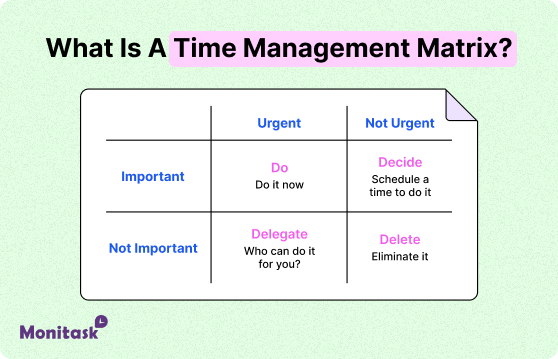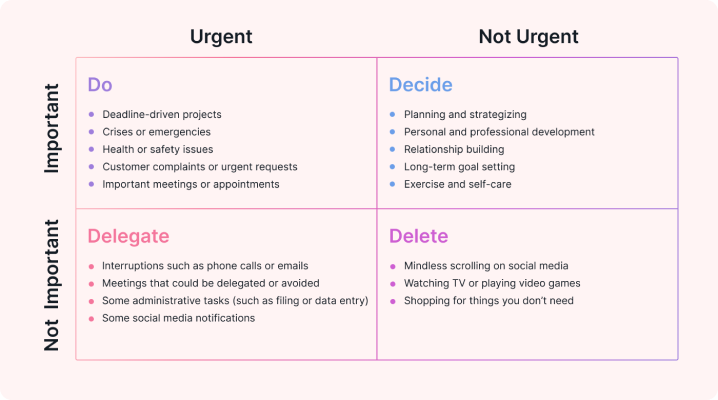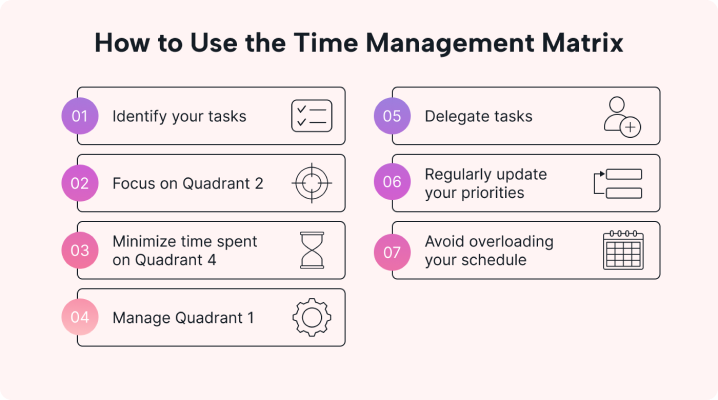Time Management Matrix: Mastering Prioritization for Productivity

In a world filled with endless tasks and competing priorities, effective time management is crucial for success.
The time management matrix, popularized by Stephen Covey in his book The 7 Habits of Highly Effective People, provides a structured approach to prioritizing tasks based on urgency and importance.
This article explores the concept, its quadrants, benefits, and practical applications to help individuals and teams make the most of their time.
What is the Time Management Matrix?
The time management matrix, also known as the Eisenhower Matrix, is a tool designed to categorize tasks into four quadrants based on two factors: urgency and importance. This framework helps users focus on what truly matters while minimizing time spent on less critical activities.
The Four Quadrants

Benefits of Using the Time Management Matrix
a) Improved Focus
By identifying tasks in Quadrant 2, individuals can allocate time to activities that align with long-term goals, enhancing focus and productivity.
b) Reduced Stress
Managing Quadrant 1 tasks effectively prevents last-minute scrambles and reduces stress caused by urgent crises.
c) Better Decision-Making
The matrix helps distinguish between tasks that demand immediate attention and those that can be delegated or postponed, enabling smarter decisions.
d) Enhanced Work-Life Balance
Focusing on important but non-urgent activities, such as exercise and family time, fosters personal growth and a balanced lifestyle.
Maximize productivity of your business
Track employee productivity and simplify work with them
How to Apply the Time Management Matrix
Step 1: List Your Tasks
Start by writing down all your tasks for the day or week. Be comprehensive and include both work-related and personal activities.
Step 2: Categorize Tasks
Assign each task to one of the four quadrants based on its urgency and importance.
Step 3: Prioritize and Plan
- Focus on Quadrant 2 tasks to prevent important activities from becoming urgent.
- Address Quadrant 1 tasks promptly to manage crises effectively.
- Minimize or delegate Quadrant 3 tasks.
- Eliminate or limit time spent on Quadrant 4 activities.
Step 4: Review Regularly
Reassess your matrix periodically to adapt to changing priorities and ensure consistent alignment with goals.

Tips for Maximizing the Effectiveness of the Time Management Matrix
Common Pitfalls and How to Avoid Them

1. Overloading Quadrant 1
Neglecting important but non-urgent tasks can lead to frequent crises. Proactively invest in Quadrant 2 activities to avoid this pitfall.
2. Misclassifying Tasks
Confusing urgency with importance can result in wasted time on Quadrant 3 tasks. Evaluate tasks critically to classify them accurately.
3. Neglecting Self-Care
Failing to prioritize personal well-being can lead to burnout. Ensure that Quadrant 2 includes activities like exercise, hobbies, and relaxation.
Conclusion
The time management matrix is a powerful tool for achieving greater productivity, reducing stress, and fostering a balanced life.
By focusing on what truly matters and avoiding distractions, individuals and teams can make meaningful progress toward their goals.
Regular use of the matrix ensures that time is spent wisely, leading to both personal and professional growth.
– The Monitask Team
Frequently Asked Questions
How often should I use the time management matrix?
It’s recommended to use the matrix daily or weekly to plan tasks and adapt to changing priorities.
Can teams use the time management matrix?
Yes, teams can use the matrix to align priorities, delegate tasks, and ensure collective focus on high-value activities.



